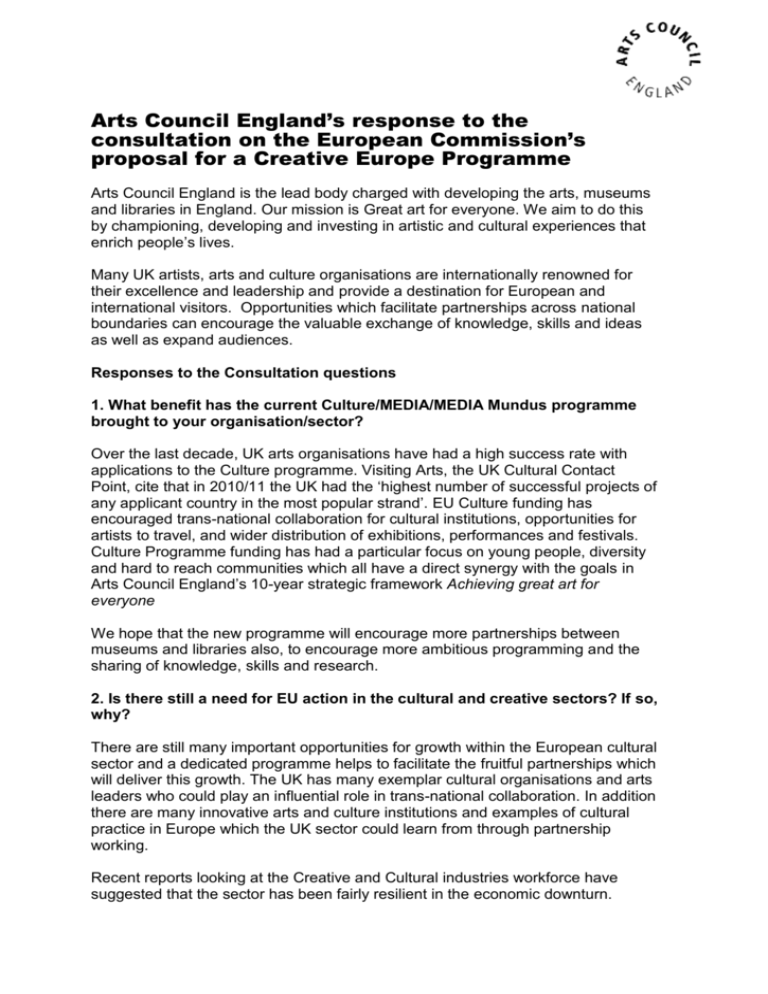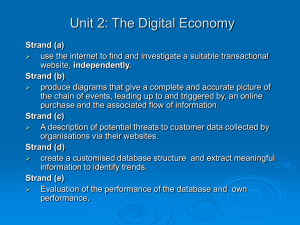Word - Arts Council England
advertisement

Arts Council England’s response to the consultation on the European Commission’s proposal for a Creative Europe Programme Arts Council England is the lead body charged with developing the arts, museums and libraries in England. Our mission is Great art for everyone. We aim to do this by championing, developing and investing in artistic and cultural experiences that enrich people’s lives. Many UK artists, arts and culture organisations are internationally renowned for their excellence and leadership and provide a destination for European and international visitors. Opportunities which facilitate partnerships across national boundaries can encourage the valuable exchange of knowledge, skills and ideas as well as expand audiences. Responses to the Consultation questions 1. What benefit has the current Culture/MEDIA/MEDIA Mundus programme brought to your organisation/sector? Over the last decade, UK arts organisations have had a high success rate with applications to the Culture programme. Visiting Arts, the UK Cultural Contact Point, cite that in 2010/11 the UK had the ‘highest number of successful projects of any applicant country in the most popular strand’. EU Culture funding has encouraged trans-national collaboration for cultural institutions, opportunities for artists to travel, and wider distribution of exhibitions, performances and festivals. Culture Programme funding has had a particular focus on young people, diversity and hard to reach communities which all have a direct synergy with the goals in Arts Council England’s 10-year strategic framework Achieving great art for everyone We hope that the new programme will encourage more partnerships between museums and libraries also, to encourage more ambitious programming and the sharing of knowledge, skills and research. 2. Is there still a need for EU action in the cultural and creative sectors? If so, why? There are still many important opportunities for growth within the European cultural sector and a dedicated programme helps to facilitate the fruitful partnerships which will deliver this growth. The UK has many exemplar cultural organisations and arts leaders who could play an influential role in trans-national collaboration. In addition there are many innovative arts and culture institutions and examples of cultural practice in Europe which the UK sector could learn from through partnership working. Recent reports looking at the Creative and Cultural industries workforce have suggested that the sector has been fairly resilient in the economic downturn. However, there is also recognition that there are concerted efforts by many of the fast growing international economies (including China) to invest in their own creative and cultural industries, meaning that the UK and Europe are at greater risk of falling behind on the international stage. In this context the opportunity of partnership and funding via Creative Europe is a vital opportunity for the sector to secure growth across Europe. 3. What would be the impact if there were no EU programmes for the cultural and creative sectors? Opportunities for the cultural and creative sectors are limited within Structural Funds. Cultural organisations rarely have the capacity to access funding which is often complex and of significant scale. Specific funding for cultural activity is a vital mechanism to encourage UK cultural exchange and the development of creative/commercial activity for UK Creative Industries. Following on from the unique international focus on the UK provided by the 2012 Cultural Olympiad, the cultural and creative sector have an excellent opportunity to take their work to new markets and form new partnerships. Creative Europe funding should enable this strategic development. 4. Do you agree that the three current programmes should be replaced by a single programme with separate Cross-sectoral, Culture and Media strands? What do you see as the benefits and/or disadvantages of this approach? The merging of the three current programmes is positive and reflects the reality of most UK arts organisations who now take a cross-sector approach to creativity, new technology and business. Arts Council England is committed to promoting an enterprising and mixed economy model within its National portfolio and the Creative Europe programme should encourage this within the context of the wider employment objectives of the Europe 2020 strategy for jobs and smart, sustainable and inclusive growth. In particular the potential for the European Investment Fund’s financial guarantee facility could make it easier for small and medium enterprises within the UK Creative Industries to access bank loans; and funding to support studies, analysis and better data collection to improve the evidence base for policy-making should help to encourage our universities and policy makers to work more effectively with the cultural sector. The Arts Council now has a wider responsibility to work with excellent museums and libraries and in this respect the convergence of arts, creative industries, heritage and education is positive within the Creative Europe programme, providing an opportunity for institutions to collaborate beyond their normal sectors on an international basis. 5. Does the proposed programme provide an appropriate framework for the kind of actions which would most benefit your organisation/sector and add value? If not, how should the framework be changed in order to maximise the benefits and added value? The Government states that EU programmes supporting research and innovation should be simple to access, flexible to use and provide value for money. By bringing the three funding programmes together, Creative Europe should provide a more streamlined approach, with better opportunity to compare and analyse performance. European added value (Article 3) 6. Does the proposal identify the right means of ensuring added value? Are there any others that should be added? Creative Europe has the potential to offer a simplified and unified approach to EU culture funding. The direct link to the ‘Europe 2020’ economic strategy may be challenging for some. However, responding to this challenge and demonstrating the added value which creative industries can play within the wider European economy should ensure that culture has an important role in EU growth, cohesion, education and employment. The programme should continue to be mindful of the continued societal and cultural value that international cultural exchange and partnership brings. Programme objectives (Articles 4-5) 7. Does the proposal identify the right general objectives for the programme? Are there any others that should be added? There is a slight risk that cultural organisations could be marginalised against digital and technology industries. However, the indicative budget proposal of 30 per cent for Culture is significant and should provide opportunity for the sector to grow. The proposal for 15 per cent for the cross-sectoral strand is welcome and positively reflects the blurring of boundaries between different artistic practices. There is an indication that bi-lateral and non EU countries may participate in the programme but there could be a strategic argument for the scheme to specifically encourage greater collaboration with the BRIC countries, where cultural exchange could be an excellent way to foster greater international collaboration, partnership and trade. 8. Does the proposal identify the right specific objectives for the programme? Are there any others that should be added? The main objectives (transnational relationships, circulation of artworks, strengthening financial capacity and development of transnational policy and business models) are welcome but understandably generic within such a broad funding programme. The proposals would be strengthened with a greater articulation of the need to engage diverse and hard to reach communities, and children and young people with culture. The recognition that all parties should work harder to ensure that a wider section of the population have access to culture has underpinned Arts Council’s 10-year strategic framework Achieving great art for everyone. Within the Creative Europe proposals the unique capacity of culture to inspire, educate and unite European communities needs to be brought into the foreground. Cross-sectoral strand (Articles 7-8) 9. Do you agree with the proposal for a new financial facility for small and medium-sized enterprises and organisations in the cultural and creative sectors? It is positive to see a loan facility proposed alongside a range of grant funded opportunities. This may have an advantage over grant making in that loans could foster longer term business planning and budget forecasting from emerging cultural and creative industries. 10. What would be the benefit of such a financial facility to your organisation/sector? Cultural and creative sectors share a range of challenges which the Creative Europe proposals cite as ‘a highly fragmented market context... the impact of the digital shift and difficulties in accessing finance’. The proposed new financial facility which goes beyond a culture of project-based grants, encourages an entrepreneurial approach. There are strong indicators that economic growth will be led by SMEs so it is welcome that new ways for them to access finance are being addressed. 11. Would such a financial facility be of greater benefit to some sub-sectors than others? If so, which sub-sectors would be likely to benefit more from the facility and which less, and why? It seems probable that cultural enterprises which operate within the digital sphere may be more alert to this type of financial practice. In addition, a number of universities are promoting opportunities for graduate creative businesses to develop from their courses. Therefore universities may have a good opportunity, with their wider experience of EU funding and strong international networks, to drive activity within Creative Europe. Arts Council’s National portfolio of funded organisations (NPOs) has strong links with Universities and could work in partnership to access EU support. 12. Is there a risk that such a financial facility could create market distortions? If so, why, and how could the impact on the market be mitigated? The creative industries have large growth potential. An EU Member States survey in early 2010 found that more than 97 per cent of respondents thought the creative industries were ‘important’ or ‘very important’ in supporting innovative activities, encouraging economic growth and creating new jobs (The European Competitiveness Report 2010). Creative Industries can drive up entrepreneurial business start up and meet the challenges around the digital shift. Compared to commercial industries the financial facility should not affect significant market distortion for creative industries which are focussed on innovation and international partnership between arts, culture, business and technology. 13. What level/proportion of the financial allocation for the programme should be allocated to such a financial facility? Within the Media strand, there seems to be a good case for a proportion of the funding to be used as loans to support emerging creative industries and new technologies. The digital shift and opportunities for digital dissemination of cultural content presents a huge opportunity in Europe and it is important that Creative Industries can access finance to enable them to increase competitiveness and respond quickly. The scheme would be most effective if the process for accessing the financial facility could be streamlined to make it as responsive as possible. The long timescales for applying into EU grant processes are a disincentive and can be unworkable for some types of projects. 14. Do you agree with the proposed support measures for transnational cooperation? Are there any other measures which should be included? The recent HM Government report: Lets Choose Growth: Why we need reform to unlock Europe’s potential, promotes the idea of ‘unleashing the single market’ and argues that reduced barriers to trade between Europe and other markets could gain 5.5 million jobs. Transnational co-operation is just as vital for the cultural sector and creative industries however it is often hard to map where activity is taking place. There is potential for Creative Europe to better communicate how its funding is enabling partnership between European countries and the wider international world. 15. Do you agree with the proposed tasks of the Creative Europe Desks’ network? Are there any other tasks which should be included? It is positive to see the support for a network of Creative Europe Desks to promote the Creative Europe Programme at national level. This should encourage more engagement from the sector and also ensure that policy and best practice is shared between professionals, institutions and networks in the cultural and creative sectors in the Member States. Culture strand (Articles 9-10) 16. Does the proposal identify the right priorities for the culture strand? Are there any others that should be added? A number of priorities add value to Arts Council England’s 10-year strategy including: transnational exchange, peer-learning activities and networking among cultural operators and policy makers. A range of Culture strand priorities propose areas of work which are largely outside of the scope of Arts Council’s immediate priorities but are welcome including: tools for skills and jobs, and support for statistical surveys and analysis in the cultural and creative sectors. Opportunities for individuals and small and medium enterprises can be overlooked within large scale funding programmes so it is encouraging to see that the Culture strand will support professional cooperation and funding to ‘internationalise careers’ which could be particularly useful for cultural workers and small and medium enterprises in isolated regions. This complements the Arts Council and British Council’s Artists’ International Development Fund. The priorities also have a strong synergy with Arts Council’s funding of international touring, events and exhibitions, and supporting audience development and engagement. While the priorities mention ‘testing new approaches to audience building and business’, there seems potential to be more explicit about the need for Creative Europe to fund projects and programmes which engage children and young people, diverse and hard to reach communities. 17. Does the proposal identify the right support measures for the culture strand? Are there any others that should be added? A number of these measures such as cross-sectoral initiatives and support to networks are familiar from the previous Culture Programme however the commitment towards ‘European platforms for the development of emerging talent’ is welcome. The commitment to a systemic approach should enable better coordination across a range of cultural activities which have previously been complex and problematic with EU culture funding. Media strand (Articles 11-12) 18. Does the proposal identify the right priorities for the media strand? Are there any others that should be added? The Arts Council has recently launched a partnership with the BBC called The Space – an experimental digital arts media service and commissioning programme that could help to transform the way people connect with, and experience, arts and culture. The Space provides a distribution platform for cultural organisations which create excellent digital content. Through this and other funding programmes, we are supporting organisations to develop their digital capacity. As this capacity increases, we hope that UK organisations will be able to access the media strand in order to access a wider audience and international market Third countries (Article 16) 22. Is it appropriate to allow access to the programme to non-EU countries on the terms set out in this Article? This seems a welcome and necessary development to encourage greater distribution of cultural products and access to new markets beyond the EU, and could enable the Arts Council and our National portfolio, and other arts and culture organisations to develop long term strategic partnerships. Arts Council England has ambitions for the arts and culture organisations it funds to show leadership on an international basis beyond Europe. Currently a range of transnational partnerships with the BRIC countries (Brazil, Russia, India and China) are under development and in this context the potential for non member states to access funding should also provide a wider range of opportunities for UK culture organisations. Final comments 24. Do you have any other comments on the Commission’s proposal? Cultural and Creative Industries are a huge asset and EU studies have indicated that they account for around 4.5% per cent of EU GDP and 3.8 per cent of employment (or 8.5 million jobs). UK artists and arts and culture organisations are at the forefront of many cultural and creative sub-sectors and have real potential for economic growth and network leadership in Europe. Arts Council England’s recent partnership with the British Council to create the Artists International Development Fund is a strong example of strategic commitment to encourage artists to internationalise their practice. The proposal to refresh EU cultural funding is timely. Arts Council England has recently restructured its national portfolio of regularly funded organisations, and launched its new Renaissance programme alongside a range of strategic funding programmes that will sustain and develop arts and culture organisations in England. In this context, the opportunity to improve competitiveness for cultural and creative industries in England presents a significant growth opportunity. Creative Europe should enable transnational exports, new international partnerships and commercial innovation through access to significant grant funding and loans via the proposed Financial Facility. The simplification of the current Culture, MEDIA and MEDIA Mundus programmes into one scheme is positive and the commitment that Creative Europe must contribute to the economic drivers of the ‘Europe 2020’ strategy is particularly welcome to ensure that the economic potential of cultural and creative industries is recognised and realised both within England and Europe.




